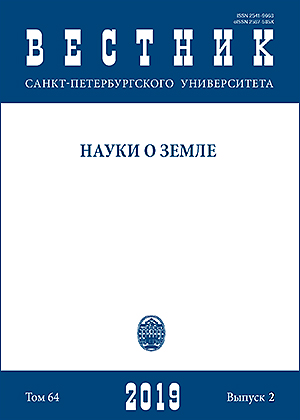Th-U-Pb-dating of monazite from the metamorphic rocks of the itkul formation of the Sysert Metamorphic Complex (Middle Urals)
DOI:
https://doi.org/10.21638/spbu07.2019.209Abstract
New data on the age of metamorphism of the rocks of the Itkul formation of the Sysert Metamorphic Complex (Middle Urals) are obtained. Amphibole-chlorite rocks from the Glubochinskoye deposit of the garnet were studied, which was partially worked by several mines. The investigated rocks are composed of chlorite (clinochlore), amphibole (sodic-ferrozhedrite, sodic-zhedrit), garnet (Alm78-65), staurolite, plagioclase (An4-18), ilmenite, fluorapatite and monazite-(Ce). We performed a microprobe study of the chemical composition of monazite and determined the age of the mineral Th-U-Pb dating method. The value of monazite age is from 273 to 314 Ma, a weighted average of 297 ± 12 Ma and isochrone of 293 ± 26 Ma (MSWD = 0,23). The age of accessory monazite shows that the formation of amphibole-chlorite rocks occurred in the early Permian times. Probably, the transformation of metamorphic rocks in the northern part of the Sysert metamorphic complex occurred at the Permian and Carboniferous boundary under the influence of a powerful thermal event. At present, this is the subject of discussions. Some researchers believe that metamorphic rocks were formed as a result of a thermal event associated with suprasubduction tonalite-granodiorite magmatism, and others that the Sysert complex was formed as a suprasubduction accretion prism.
Keywords:
chemical dating, monazite, metamorphic rocks, itkul formation, Sysert Metamorphic Complex, Glubochinskoye deposit, Middle Urals
Downloads
References
References
Downloads
Published
How to Cite
Issue
Section
License
Articles of "Vestnik of Saint Petersburg University. Earth Sciences" are open access distributed under the terms of the License Agreement with Saint Petersburg State University, which permits to the authors unrestricted distribution and self-archiving free of charge.






